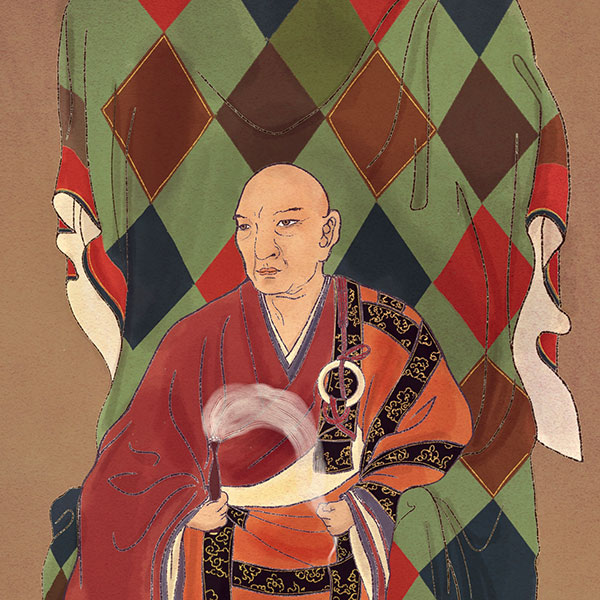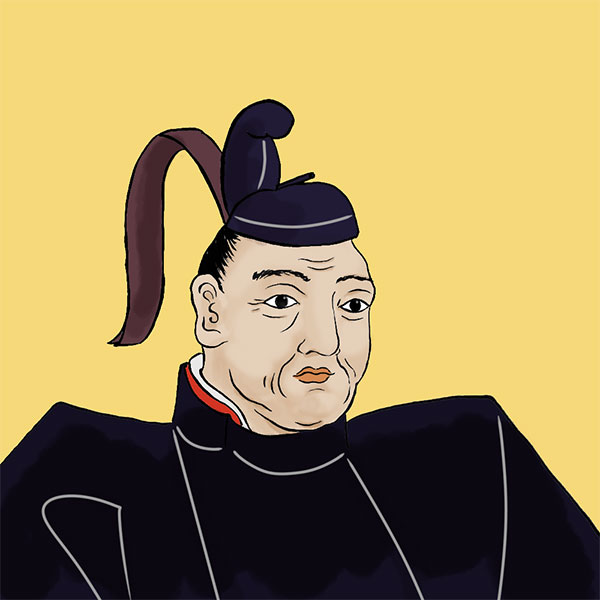Laws of the Imperial Court and the Nobles (1/2)The Edo Shogunate controlled the Imperial Court and the nobles

Laws concerning the Imperial Court and the Nobles
- Article category
- case file
- Incident name
- Laws for the Imperial Court and the Nobles (1615)
- place
- Tokyo
- Related castles, temples and shrines

Edo castle
- people involved
The Edo Shogunate issued various laws to regulate feudal lords, samurai, the Imperial Court, and the nobles. For samurai, the second shogun, Tokugawa Hidetada, issued the "Buke Shohatto" in July 1615 (the 20th year of the Keicho era, the first year of the Genwa era). For the Imperial Court and the nobles, he issued the "Kinchu Namari Kuge Shohatto" at roughly the same time. The Kinchu Namari Kuge Shohatto attempted to further strengthen the power of the Edo Shogunate by restricting the Imperial Court and the nobles from interfering in politics. In this article, we will explain the Kinchu Namari Kuge Shohatto in an easy-to-understand way, including the circumstances under which it was issued and its contents.
What are the Imperial Court and Court Noble Laws? What are their similarities and differences with the Buke Laws?
The Imperial Court and Courtiers' Laws (also known as the Imperial Court and Courtiers' Laws) were issued on July 17, 1614, to regulate the Imperial Court and courtiers. On the other hand, the Buke Shohatto was issued on July 7, aimed at daimyo and samurai, and is aimed at a different audience. Also, the era name was changed from Keicho to Genwa on July 13, 1615, so the Buke Shohatto was issued in 1615 and the Imperial Court and Courtiers' Laws in 1616, but the difference is only 10 days.
The reason why laws were issued one after another at this time was because the Toyotomi clan was destroyed in the Summer Siege of Osaka in May 1615. When the Edo Shogunate was established, the Toyotomi clan still existed and was in conflict with the Tokugawa clan, so the government was unstable. With the demise of the Toyotomi clan, the hostile forces of the Edo Shogunate, or the Tokugawa Shogunate, were no longer visible.
The drafter of both the Imperial Court Laws and the Laws for the Buke and the Kudo Laws was the same Rinzai sect monk Konchiin Suden. He was Ieyasu's brain, and was also known as the "Black Robe Prime Minister," responsible for drafting bills, diplomacy, and even controlling religion. However, the Laws for the Imperial Court and the Kudo Laws were revised based on the opinions of the nobles.
The biggest difference between the Imperial Court Laws and the Buke Laws is the number of times they were issued. The Imperial Court Laws and the Buke Laws were originally called "Kuge Laws," and at the end of the 17th century, "Kinchu-nami" was added to the beginning to make them "Kinchu-nami Kuke Laws," but the content has not changed. On the other hand, the Buke Laws and the Buke Laws have been reissued almost every time a new Shogun came around, starting with the first one called "Genwa-rei" (it was not issued during the time of the 7th Tokugawa Ietsugu and the 15th Tokugawa Yoshinobu).
Who issued the Imperial Court and Court Nobles Laws?
The Imperial Court and Noble Laws were issued at Nijo Castle with the joint signatures of three people: the great Tokugawa Ieyasu, the second shogun Tokugawa Hidetada, and the former regent Nijo Akizane. As Nijo Akizane's signature was the first and the law was enacted based on the opinions of the nobles, it seems that the Imperial Court accepted it to a certain extent, rather than it being a unilateral imposition by the shogunate.
What were the contents of the Imperial Court and Court Noble Laws?
The Imperial Court Laws and Regulations for the Imperial Family and the Nobles are written in classical Chinese and consist of 17 articles. The first 12 are regulations that the Imperial family and the nobles must follow, and from article 13 onwards, they contain regulations concerning the official ranks of monks. The original was destroyed in a fire in 1661 (Manji 4) and was later restored based on a copy. Let's take a look at the contents.
Article 1: The first of the arts and learning that an emperor must master is learning. By learning, one can conduct good government affairs and realize peace. This is written in the "Jogan Seiyo." The "Kanpei Ikai" also states that one should read and study the "Gunsho Jiyo." In addition, waka poetry is a traditional Japanese custom that has continued since Emperor Koko and should not be abandoned.
→This is a quote from "Kinpisho," a book of court customs written by Emperor Juntoku in the Kamakura period. It has been said that this first article means that "the Emperor should devote himself to academics, regardless of politics," but recent research has shown that this cannot be said in general, given the names of "Zhenguan Zhengyao" (a textbook on imperial studies that records the words and deeds of Emperor Taizong of the Tang Dynasty) and "Gunsho Chiyao" (a political book from the Tang Dynasty).
Articles 2 and 3: The three ministers (Grand Minister, Left Minister, and Right Minister) are above the Imperial Prince. The former Minister is below the Imperial Prince.
→ The nobles (ministers) who run the Imperial Court are ranked higher than the princes who are the next emperors. This shows how powerful the nobles are.
Articles 4 and 5: Even if they were from the Fujiwara clan, those who were incompetent could not become regents, chancellors, or the three ministers. However, if they were competent, they did not have to resign even when they grew old, and they could be reappointed.
→If you read between the lines, the Edo Shogunate would decide whether or not someone had the ability. In other words, the regent, chancellor, and three nobles could only be appointed by those approved by the Shogunate. Incidentally, immediately after the issuance of the Imperial Court and Court Nobles Law, Nijō Akizane returned to the position of chancellor, which was an extremely unusual event at the time.
Article 6: Adopted children must be chosen from those with the same surname. Women cannot inherit the family estate.
Article 7: The number of official ranks for the samurai class is unrelated to the ranks for the nobles.
→The Edo Shogunate was now free to award military ranks to samurai. However, the Imperial Court was responsible for awarding these ranks.
Article 8: When changing the era name, choose a good Chinese word. However, if the person in charge has sufficient experience, it is okay to follow a Japanese precedent.
Article 9: Detailed regulations regarding the formal attire of the Emperor and nobles.
Article 10: Promotion of court nobles should be in accordance with the old laws. However, those who have devoted themselves to scholarship, court nobility, or waka poetry or have made achievements should be promoted or recommended.
Article 11: If a court noble does not obey the orders of the regent, denso, or magistrate, he should be exiled.
→This denso refers to the "Buke Denso", a bridge between the Shogunate and the Imperial Court. In other words, if you go against the Shogunate's wishes, you will be exiled. This is an important clause for the Shogunate to control the Imperial Court.
Article 12: The severity of a crime shall be determined in accordance with the law of precedent.
→ The Meirei-Ritsū is a code that is considered to be part of the Yoro Code that was established during the Nara period. It is based on the five punishments (flailing, caning, imprisonment, exile, and death) and the eight cruelties (treason, conspiracy, treason, evil, immorality, great disrespect, filial piety, and iniquity).
Articles 13 to 15: Stipulates the rank of the monzeki, such as that the sekke monzeki is lower than the shinno monzeki. It also stipulates how to decide on the sōjō, monzeki, inke, and sōzu.
Article 16: There have been few chief priests permitted to wear purple robes, but in recent years imperial permission has been issued without due consideration, disrupting the rank order and sullying the name of the temple, which is very bad. From now on, purple robes should be given to those who are worthy, taking into account the individual's abilities.
→ If you read between the lines, it means that "to give a purple robe, permission from the shogunate is required." This leads to the later "Purple Robe Incident" (see below).
Article 17: Stipulates that the priest shall be selected by imperial sanction from the Emperor.
What was the purpose of the Imperial Court and Court Nobles Laws? The trigger for their creation: the Inokuma Incident
The Imperial Court and Nobles Act gave the Edo Shogunate the power to control the Imperial family and the nobles. However, as mentioned above, this was not a unilateral announcement by the Shogunate, but included the will of the Imperial Court.
There is a continuation in the article on the Imperial Court and Court Nobles Laws
- people involved

- WriterNaoko Kurimoto(Writer)I am a former travel industry magazine reporter. I have loved history, both Japanese and world history, since I was a child. I usually enjoy visiting temples and shrines, especially shrines, and often do ``pilgrimages to sacred places'' themed around historical figures. My favorite military commander is Ishida Mitsunari, my favorite castle is Kumamoto Castle, and my favorite castle ruins is Hagi Castle. My heart flutters when I see the ruins of battle castles and the stone walls of castle ruins.





